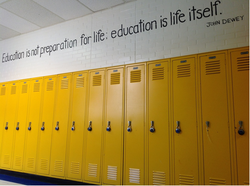However, there are two WAY cooler functions that make it one of the most useful tools in our edtech toolbelt.
When you create a playlist, you can either make it privately or publicly editable. We usually use the private setting for our course content, but we use the latter option a lot in Desktop Publishing. I will create an empty playlist and is publicly editable and give students a bitly link to it so they can add work they have created around a common theme or topic. We have done a publicly editable playlist to facilitate students’ sharing major projects with one another, as we did with The Crucible. But there is an even better use with a more real-world audience.
We’re only a couple days into the school year, but I’m beginning the process of training the kids how to be tech trainers themselves, so they can help their own teachers when the teachers are struggling. So I’m having the students make walkthroughs--like, “here’s how you make a Google Form” or “Here’s how you make a slideshow that isn’t ugly.” I then have students load all of their individual walkthroughs on a playlist.
The benefits there are multiple. First, everyone can see everyone else’s work, which tends to increase the level of work right off the bat. Second, it allows me to say things like, “OK, friends, click through the steps on this list and tell me which one(s) are the most helpful.” Most importantly, it lets me do what I just did this afternoon, which is send out a link to the Google Form walkthrough playlist to a dozen teachers at my school who wanted to learn how to use Forms. They can now actually test the walkthroughs--try to follow the directions, and then give feedback to students about where theirs fell short. And the more real-world audiences students can get, the better they get, and the faster they get there.
We also use LP to have students make playlists that function as portfolios of all their work for class. Every time they submit something to us digitally, we have them add the assignment to an individual playlist. That way, all of their assignments end up together, and it becomes really easy to track their growth over the course of a semester.
One more super useful function is that you can organise presentations in the order in which they present. This is particularly helpful when you have lots of groups to present and not much time. Having all the slide decks in a playlist makes it easy to move from group to group without too much down time.
Another big selling point for us is that you don’t need a separate login - you can use your google login. That alone makes it better than an LMS, because trying to have students remember a bunch of different login information is difficult at best.
Are there any other ways you use LP in your classroom? We would obviously love to steal them from you.
Note: this is a sister post to Cheryl's edtech post on ShowMe.


 RSS Feed
RSS Feed
